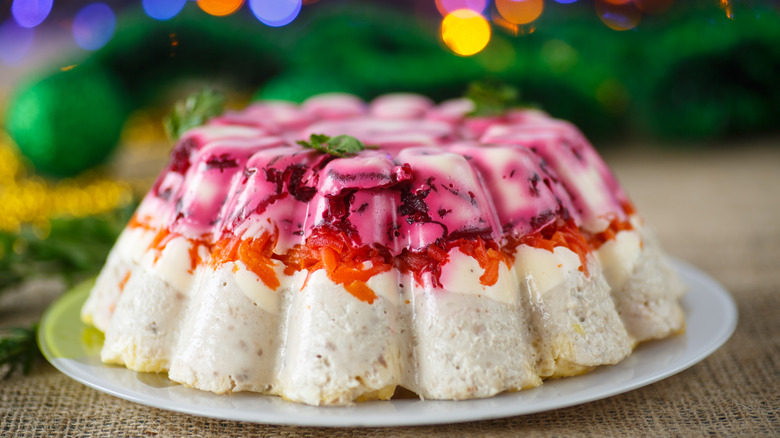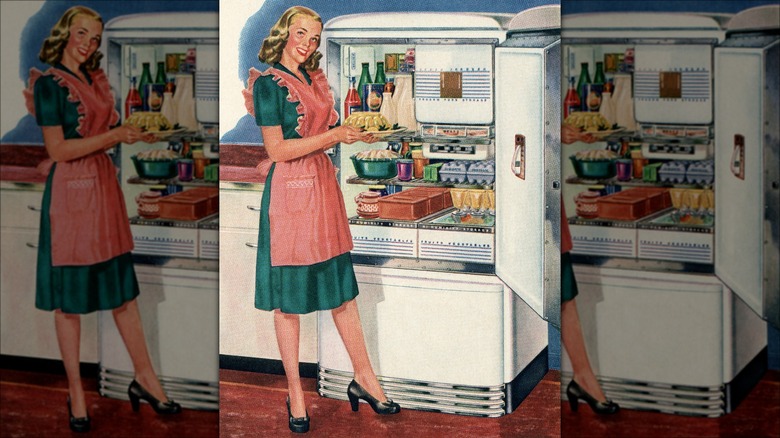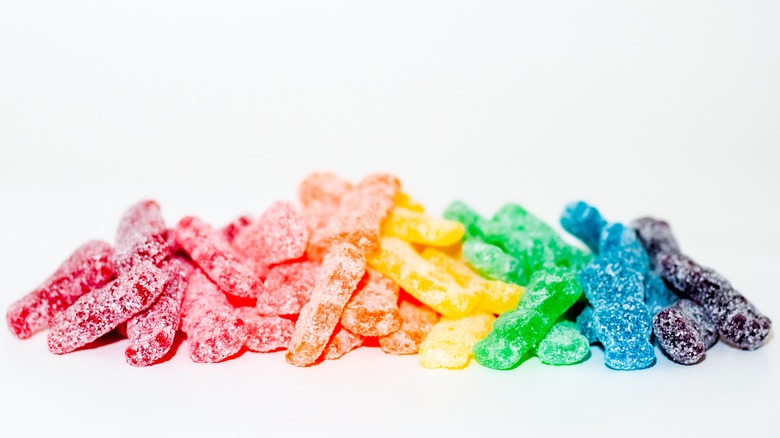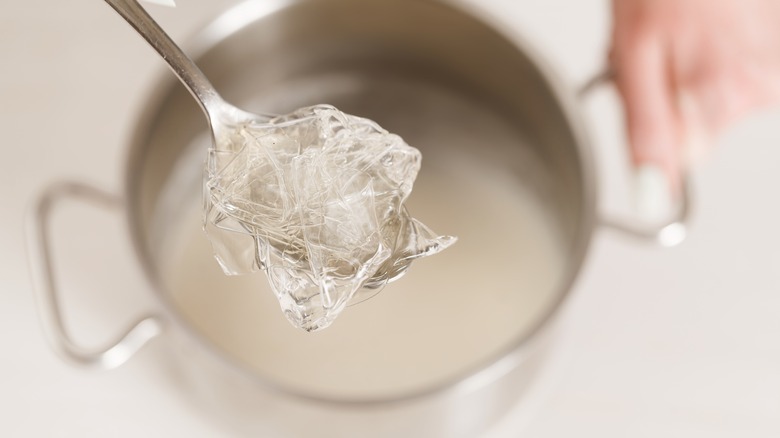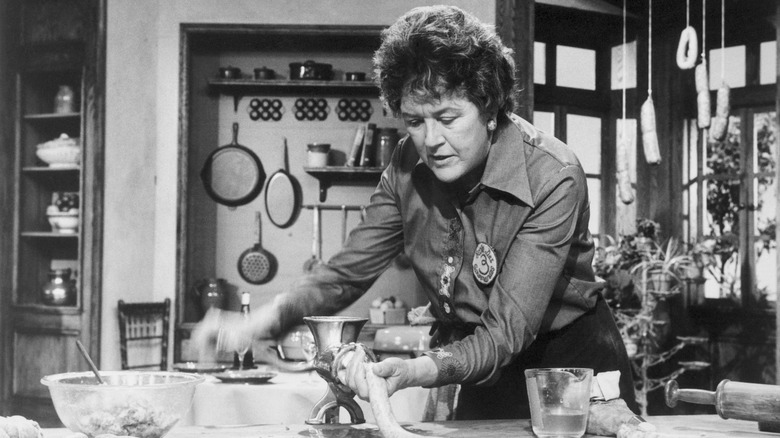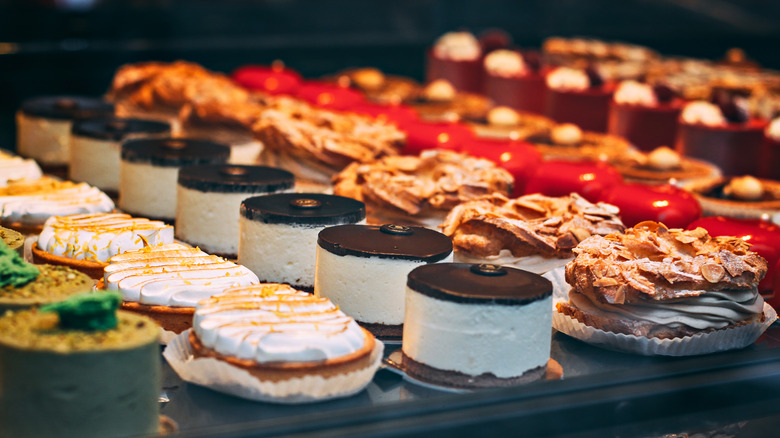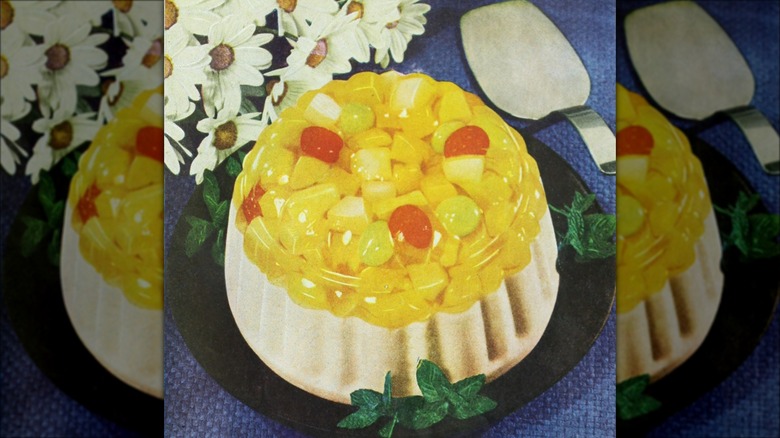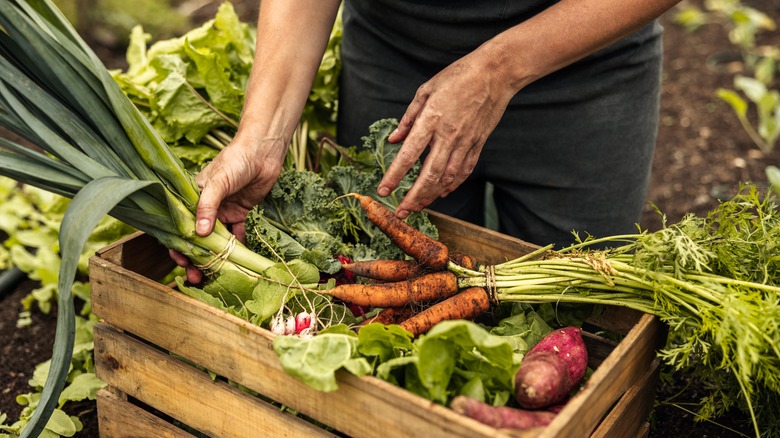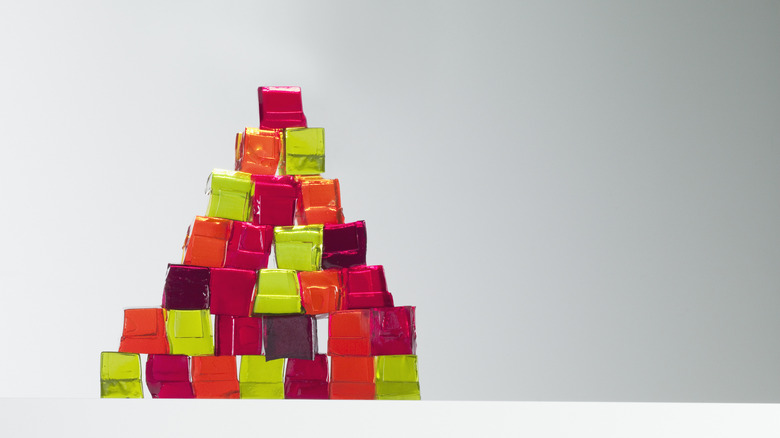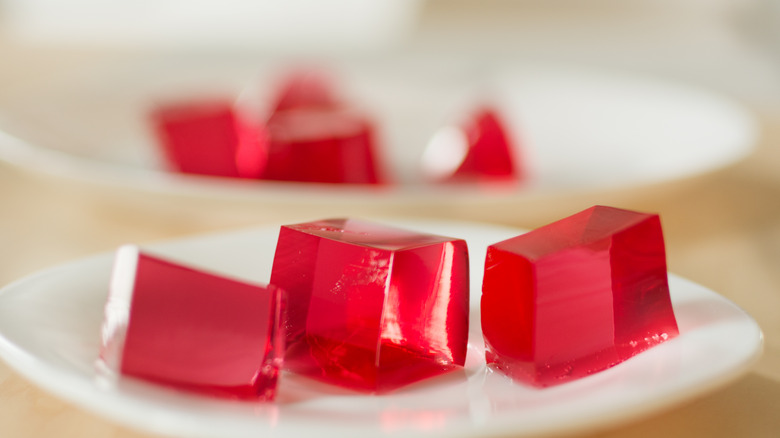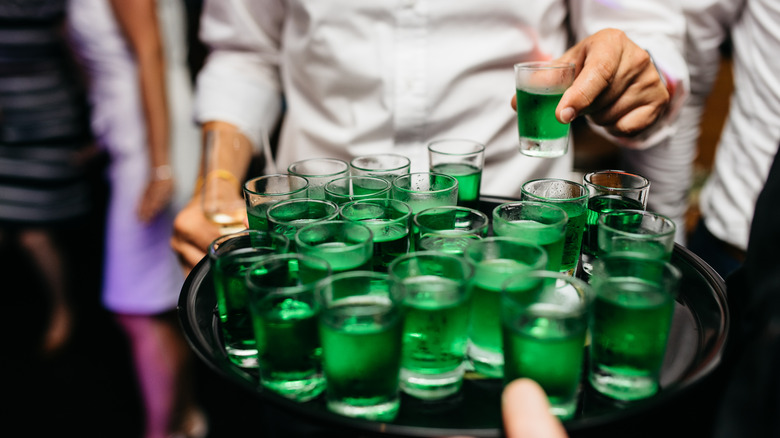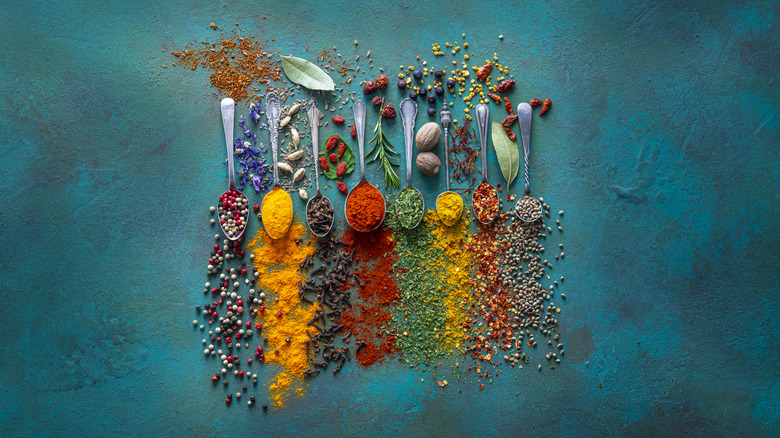Why Jell-O Salad Isn't As Popular Today As It Once Was
If you attended a dinner party and discovered that the hosts had centered the meal around a wobbly, translucent main dish of tuna suspended in glistening gelatin, you might end the friendship right then and there. Once the height of sophistication, Jell-O salad has slid so far off the culinary map in the past 50 years that it is almost a punchline, signifying just how much the world of home cooking has evolved over the decades. With its easy preparation and colorful, glistening appearance, Jell-O salad offered homemakers a visually appealing yet extremely convenient centerpiece for meals that would impress family members and guests. Women's magazines gleamed with images of shimmering Jell-O salads, from sickeningly green lime concoctions made with cottage cheese and seafood to supposedly barbecue-inspired versions made with lemon Jell-O, tomato sauce, vinegar, and mayonnaise.
Despite how delicious these creations no doubt sound, by the end of the 20th century, the country's love affair with Jell-O salad had flatlined. People were still eating colorful gelatin, but they were no longer serving it as a main course as frequently as they used to. These days, it's more of a quirky novelty snack than an accepted meal option. To understand why this culinary innovation met such a swift decline, it's necessary to look back at why it became such a phenomenon in the first place and the cultural changes that shaped its present status at the bottom of the gastronomic hierarchy.
Its popularity was based on specific societal conditions of the postwar era
Following World War II, U.S. women were joining the workforce for the first time, but gender stereotypes about domesticity were alive and well. Despite holding down jobs, they were still expected to shoulder the responsibilities of child-rearing, homemaking, and home-cooked meals. These time constraints led food manufacturers to increasingly focus on convenience while also ensuring that women could put their personal spin on each dish to avoid looking like they had simply purchased readymade meals. This balance was all too important. Swanson, the company behind the first TV dinners, reportedly received letters from angry husbands accusing the brand of killing home-cooked meals (per Smithsonian Mag). And results of a 1950 survey published by the Journal of Marketing found that female respondents labeled women who used instant coffee over drip coffee as "lazy, disorganized, a spendthrift, and a bad wife," according to "Something from the Oven: Reinventing Dinner in 1950s America" by Laura Shapiro.
Jell-O salads provided a convenient middle ground. By dumping a can of sardines and some sliced boiled eggs into a star-shaped mold filled with red Jell-O, a busy housewife could have a unique and, at the time, appealing dish that her family could rightfully attribute to her ingenuity. With an onslaught of mind-bendingly random recipe suggestions appearing in cookbooks and magazines (strawberry Jell-O with pickles and tomatoes, anyone?), homemakers were encouraged to dream big with their wobbly presentations, and gelatin-based meals became a household staple.
Artificially colored foods have become controversial
Humans have been coloring foods naturally for thousands of years with substances such as saffron, beets, and copper oxides. The creation of the first synthetic food coloring in 1856 prompted an explosion in artificially colored products. Lack of regulation led to serious consequences. Some artificial colorings were made with toxic substances such as lead, arsenic, and mercury, and they were sometimes used to hide food impurities, per the U.S. Food and Drug Administration (FDA). Even after 1906, when Congress passed the Food and Drugs Act prohibiting toxic chemicals and the use of dyes to conceal spoiled food, manufacturers found ways to skirt the law.
In 1960, a decade after children became sick from consuming orange food coloring in Halloween candy, Congress passed the Color Additive Amendments, laying out clear guidelines for the FDA to regulate such additives. However, the backlash against these products continued. The Center for Science in the Public Interest, a nonprofit consumer watchdog in Washington, D.C., claimed on multiple occasions that some artificial food colorings approved by the FDA were connected to hypersensitivity, behavioral problems in children, and even cancer. Due to health concerns, the state of California has banned the use of red dye No. 3 beginning in 2027, per NBC News.
Given these controversies, it's no surprise that, since the heyday of brightly colored Jell-O salads in the 1950s and 1960s, many Americans have grown less enthused at the prospect of a neon green or cherry red main course.
Gelatin has lost its shine for some
When you slurp down a spoonful of grape Jell-O, you probably aren't thinking about byproducts from animal skin, bones, and cartilage, but like it or not, that's probably what you're eating. If you've ever noticed the clear, gelatinous layer that develops on the top of chicken soup when it's refrigerated, you'll have seen, perhaps without realizing it, how collagen can be rendered from animal parts. People have been using this jelly in sweet dishes since medieval times, but it's hardly surprising that gelatin brands like Jell-O are not particularly keen on advertising the precise origins of their exquisitely colored, fruitily flavored products. Powdered and granulated gelatin hit the market in the mid-1800s, allowing chefs and home cooks to conveniently ignore where it came from, especially when colors and flavors were added.
Over the years, however, vegetarian and animal rights movements have reminded consumers what their gelatin is made of, prompting some to omit it from their diets. Chowing down on a berry-flavored dessert made out of the byproducts of meat production creates a cognitive dissonance that even some non-vegetarians struggle to reconcile, especially when animal rights advocates paint vivid descriptions of boiled animal parts. This alone doesn't explain the decline in the popularity of Jell-O salad, but it is likely a contributing factor.
Our definition of home cooking has changed
In the early 20th century, the latest innovations in the food industry were all about readymade products. Packages of cookies, jars of mayonnaise, cans of cranberry sauce, and sliced bread all made their debuts during this period, drastically reducing the amount of time women spent in the kitchen preparing food. The trend continued through the 1950s and 1960s as convenience products like Jell-O and Campbell's Soup gave women more control over their schedules. But things began to change. Following decades of advancements in processed foods, a new trend took hold, thanks in large part to one woman.
When "The French Chef" hit television screens in 1963, it made a star out of Julia Child, whose book, "Mastering the Art of French Cooking," had already made waves across the country. Child's warmth and self-effacing informality made French cooking accessible to millions of Americans, proving that bouillabaisse and omelets did not have to be the domain of exclusive, metropolitan restaurants but could be replicated at home from scratch. Her television career spanned more than three decades, and along with the likes of James Beard and Jacques Pépin, she inspired home cooks to try their hands at recipes that didn't involve packets of gelatin. These days, if you turned up to a party wielding a plate of red gelatin topped with sardines and mayonnaise, it would probably seem more out of place than if you turned up with a loaf of homemade sourdough.
There are even more convenient meal options
Jell-O salad was popular because of how convenient it was. If you needed to make a dessert, it was much quicker to whip together a Watergate salad than to bake a cake. If you needed an attractive main dish, it was much easier to throw together a can of soup and some gelatin than to spend hours chopping and stirring meat and vegetables. However, convenience foods have rapidly evolved since the 1950s. Premium cake mixes of every flavor can now make time-poor home bakers feel like professional pastry chefs, while any grocery store worth its salt sells rotisserie chicken that tastes better than anything you could make at home.
Readymade desserts are also more appealing than ever. A 2016 report from Progressive Grocer found that sales from supermarket bakery departments reached $13.5 billion the previous year and were projected to rise a whopping 45% between 2010 and 2020. Stores have been rapidly diversifying their options to meet consumer demand, supplying everything from celebration cakes to freshly baked bread. They have even found a way to meet the appetite for health-conscious options. According to a 2018 report from New Hope Network, in-store bakeries have been branching out into organic ingredients, whole grains, and ethically sourced animal products. It's never been easier to find affordable, diverse, high-quality prepared foods, which overshadows the advantages of Jell-O salad.
Jell-O is associated with hospitals
If you've ever spent time in the hospital as a patient or with a sick loved one, you might have noticed that one of the main foods served after a procedure is Jell-O. While this may seem like an arbitrary choice of snack that has more to do with financial constraints than health considerations, it is actually highly intentional. While Jell-O offers little in the way of nutrients, it is mostly comprised of water, gelatin, and sugar, providing patients with hydration and energy when they are too ill to digest more complex foods.
Any meal associated with hospitals will inevitably carry negative connotations for many, especially those who have had traumatic experiences in that setting, and Jell-O is no different. Despite its sugary flavor and playful colors, its reputation can't escape the fact that many people associate it with one of the places that most of us try to avoid at all costs.
It looks old-fashioned
The decline of Jell-O salad is a vicious cycle. The less people make it, the more old-fashioned it looks, and the more old-fashioned it looks, the less people want to make it. While many food trends enjoy a renaissance at some point once they qualify as being "retro," others never quite manage to find new fans.
Jell-O is still popular in many places as both a snack and as a dessert. It was named Utah's official state snack in 2001, and as recently as 2023, the brand revamped its packaging to appeal to more modern aesthetics (per CNN). But Jell-O salad is different. Decorative molds are more associated with old-fashioned pound cakes than trendy desserts or savory entrees, and wobbling domes of gelatin encasing liver and fish are a tough sell to modern sensibilities. The further we get from the 1950s, the more outlandish such a dish appears.
Compared to the delicate jelly-based desserts made in many Asian countries with the seaweed-derived gelatin substitute agar, Jell-O salad lacks finesse and modernity. While a Japanese raindrop cake is an Instagram-ready minimalist showcase, a stereotypical Jell-O salad is as understated as a Christmas sweater and, like a Christmas sweater, is usually only invoked for the sake of irony.
[Featured image by Ladies' Home Journal via Wikimedia Commons | Cropped and scaled | Flickr API]
It clashed with the fresh food movement
By the 1970s, American tastes and concerns about food were shifting. The environmental movement was blossoming, and there was a greater interest in the nutritional value and freshness of foods rather than in their convenience. The counterculture movement was pushing back against pesticides and industrialized food, and up-and-coming chefs were joining the charge. Along with the French-inspired authors and celebrity chefs of the era including Julia Child and James Beard, Alice Waters was instrumental in introducing the American culinary scene to fresh, local ingredients and their impact on flavor.
In 1971, Waters opened Chez Panisse, a restaurant that focused on seasonal, local ingredients. Although the average American diner was probably unaware of its existence, the restaurant had an outsized influence on the nation's relationship with food, making fresh, locally sourced food more popular than packaged alternatives that provided entire meals with nothing more than five minutes in the microwave, per author Paul Freedman.
In the '80s and '90s, the organic movement further demonstrated consumers' growing interest in the origins of their food. Given this new landscape, it's no surprise that Jell-O salad, a concoction that does not resemble anything you'd find in the natural world, fell out of favor.
It was rebranded as a snack food
As the American appetite for Jell-O began to wane in the 1970s, the brand made a hard pivot to resuscitate its struggling product. At the time, Americans were more enthused about bœuf bourguignon and fondu than towering domes of fish-filled gelatin, and the situation on the homefront was changing as well. More women were juggling jobs on top of their domestic responsibilities, and making meticulous dinners every night was no longer a priority for them. Recognizing that the traditional packets of granulated Jell-O were unpopular from a gastronomic and convenience standpoint, Jell-O rebranded itself as a snack food.
The move may have saved the brand from ruin, but it also sped the decline of Jell-O salad. Suddenly, colorful Jell-O cups filled grocery store shelves, offering an enticing snack for sugar-crazy children and saving parents from the hassle of having to pour water over Jell-O powder and wait for it to set in the fridge. Readymade Jell-O was a hit with consumers, and the brand leaned into its new identity. Its rebrand culminated in Jigglers, bite-sized pieces of gelatin molded into playful shapes that could be eaten with even more ease than Jell-O cups or Pudding Pops. The company invested heavily in a marketing campaign featuring then-megastar Bill Cosby, and Jell-O salad was all but forgotten.
Jell-O doesn't have much going for it nutritionally
Even fans of Jell-O would struggle to argue that it's good for you. The fact that it's low in calories and fat makes it less unhealthy than many foods you'd find in the snack section of the supermarket, but it doesn't have anything healthy in it either. The reason Jell-O is served to patients in hospitals is that it is mostly sugar and gelatin. If you're dehydrated and can't drink water for some reason, it might be beneficial, but as Tufts Medical Center points out, the snack is considered a clear liquid and does not contain any health benefits. Its sugar content is also hard to ignore. One 96-gram Jell-O cup, for example, has 17 grams of added sugar, which equates to more than four teaspoons.
A lack of nutritional value does not stop other products from being popular, but the fact that Jell-O is regularly marketed toward children as a snack food rather than as a dessert means that some parents choose to stick with healthier options. Sugar-free Jell-O is available, but there aren't many other ways that the company can make its product better for you. Even if it were to make an option with organic ingredients or fruit juice instead of refined sugar and artificial flavors, it would still lack nutrients.
Jell-O is now associated with frat parties, not fine dining
Aside from childhood snacking and the state of Utah, Jell-O has another association that has nothing to do with salad: college parties. Jell-O shots rose to prominence sometime in the late '80s or early '90s. Legend has it that esteemed satirist, mathematician, and singer-songwriter Tom Lehrer invented the product as a way to sneak alcohol into a party on a military base in the mid-1950s, but the true origins of the innovation date back much further. Before the Jell-O brand existed, world-famous chef Antonin Carême made orange-flower and pink champagne jelly for the likes of Napoleon Bonaparte and the Romanovs, per Slate.
As we know them today, however, Jell-O shots are largely the domain of rowdy college gatherings, and for good reason: They are the perfect disguise for cheap-tasting alcohol and simultaneously remind you of childhood at a time when you might be missing home. For college students, it's a match made in heaven. In the hierarchy of common uses for Jell-O, salad ranks far behind school lunches and college drinking games.
The American palate has evolved
Perhaps the biggest factor in the demise of the Jell-O salad is flavor. The explosion of cooking shows on television since the 1960s — from Julia Child to Gordon Ramsay — has empowered Americans to try new things in the kitchen. Meanwhile, the influx of global cuisines through immigration during the latter half of the 20th century has helped the country develop more nuanced palates. By the 1980s, bland meals of meat and potatoes were supplemented by everything from Pad Thai to rice and beans, and chain restaurants focusing on international cuisine and high-quality ingredients became part of the fabric of the country alongside traditional establishments like Whataburger and McDonald's. Under the influence of French chef Jacques Pépin, for example, Howard Johnson began serving food made from scratch (per AARP). Meanwhile, a new chain called Wendy's was serving up fresh, never-frozen burgers.
Even now, American tastes continue to evolve away from what they were in the mid-20th century. Gen X has more complex food preferences than the baby boomer generation, and recent research has shown that, while both millennials and Gen Z-ers prefer Mexican food over milder Italian food, Gen Z's preference is stronger, via Learning English. Our idea of a delicious meal is increasingly different from when people thought Jell-O salad was the height of sophistication, and unless innovative chefs begin adding more appetizing flavors to gelatin than mayonnaise and tomato soup, the popularity of the dish is unlikely to improve.
